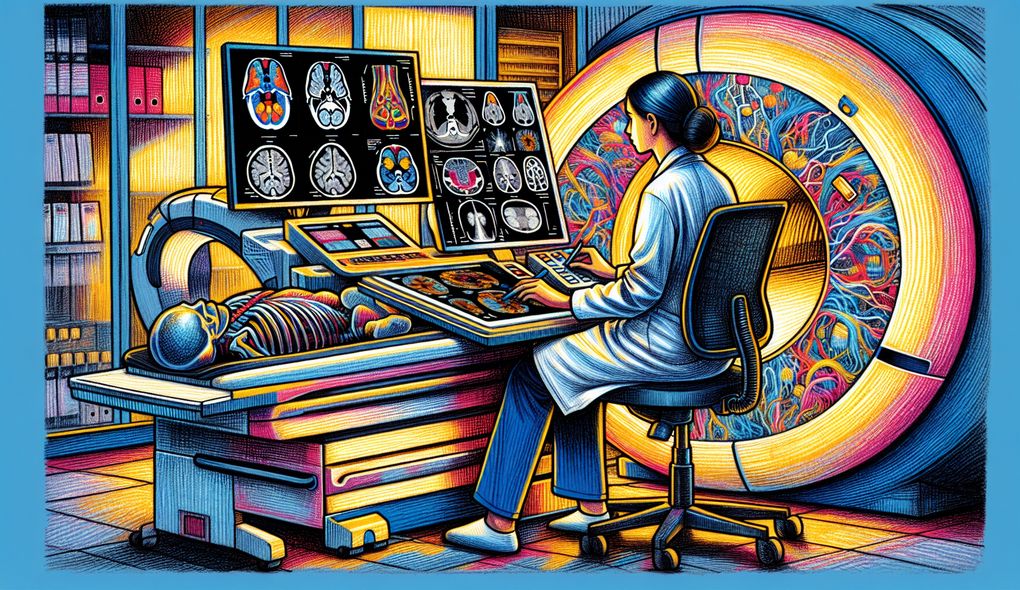How do you handle situations when there is conflicting information or data in a radiology report?
JUNIOR LEVEL

Sample answer to the question:
When faced with conflicting information or data in a radiology report, I would carefully review the report and the images to identify the inconsistencies. I would then consult with the referring physician, radiologists, or other experts to gather additional information and clarify any doubts or discrepancies. Communication plays a crucial role in resolving conflicting information, so I would make sure to discuss the findings with the relevant stakeholders and seek their input. If necessary, I would also conduct further tests or imaging studies to obtain more accurate and reliable results. Ultimately, my goal would be to ensure the highest level of accuracy in diagnosing and treating patients by resolving any conflicting information.
Here is a more solid answer:
When faced with conflicting information or data in a radiology report, my strong analytical and problem-solving abilities come into play. I would carefully analyze the report, comparing it to the images and identifying any inconsistencies or discrepancies. To ensure accurate and reliable results, I would then collaborate with radiologists, referring physicians, and other experts by engaging in open and effective communication. By discussing the findings and seeking their input, we can collectively address the conflicting information. If needed, I would suggest conducting additional tests or imaging studies to obtain more conclusive results. This demonstrates my commitment to continuous education and staying updated with advancements in radiology. In terms of using medical imaging technologies, I am proficient in utilizing various software and tools to enhance image quality and accuracy. Overall, my approach to handling conflicting information is to apply my analytical skills, communicate effectively with the team, and utilize the latest medical imaging technologies to ensure the highest level of accuracy in diagnosing and treating patients.
Why is this a more solid answer?
The solid answer expands on the basic answer by providing specific examples of using analytical and problem-solving abilities, communication skills, collaboration in a multidisciplinary team, commitment to continuous education, and proficiency in medical imaging technologies. It emphasizes the importance of engaging in effective communication and utilizing the latest technology to ensure accurate and reliable results. However, it could further improve by including examples of specific collaboration scenarios and mentioning any relevant continuous education efforts.
An example of a exceptional answer:
Handling situations with conflicting information or data in a radiology report requires a systematic approach that I have developed over the years. Firstly, I would thoroughly review the report, images, and relevant patient history to identify any inconsistencies. To address these conflicts, I would engage in a collaborative discussion with the radiology team, including radiologists, referring physicians, and experts in the specific area of concern. This allows for a comprehensive analysis of the conflicting information and a joint decision on the best course of action. Additionally, I continuously educate myself on the latest advancements in radiology by attending conferences, workshops, and online courses. This ensures that I am equipped with up-to-date knowledge and skills to tackle complex cases. Furthermore, my proficiency in using medical imaging technologies enables me to leverage advanced tools for image analysis and enhancement. By exploring alternative imaging modalities or techniques, I can often resolve conflicting information and provide a more accurate diagnosis. Overall, my exceptional approach combines thorough analysis, collaboration, continuous education, and technological expertise to navigate through situations with conflicting information in radiology reports.
Why is this an exceptional answer?
The exceptional answer provides a comprehensive and detailed approach to handling conflicting information in radiology reports. It emphasizes a systematic approach that involves thorough review, collaborative discussion, continuous education, and leveraging technology. The candidate showcases their experience, expertise, and commitment to staying updated with advancements in radiology. The answer is well-structured and provides specific examples of collaborative discussions and continuous education efforts. It demonstrates a high level of competence and adaptability in addressing conflicting information in radiology reports.
How to prepare for this question:
- Familiarize yourself with common scenarios that can lead to conflicting information in radiology reports, such as technical limitations, patient movement, or ambiguous findings.
- Stay updated with the latest advancements in radiology by attending conferences, workshops, and online courses. This will enhance your knowledge and equip you with new problem-solving approaches.
- Develop strong communication skills to effectively discuss and clarify conflicting information with the radiology team and other stakeholders.
- Practice analyzing and comparing radiology reports and images to identify inconsistencies and discrepancies.
- Stay curious and proactive in exploring alternative imaging modalities and techniques to address conflicting information.
What are interviewers evaluating with this question?
- Strong analytical and problem-solving abilities
- Excellent communication skills
- Ability to work collaboratively in a multidisciplinary team
- Commitment to continuous education
- Proficiency in using medical imaging technologies

